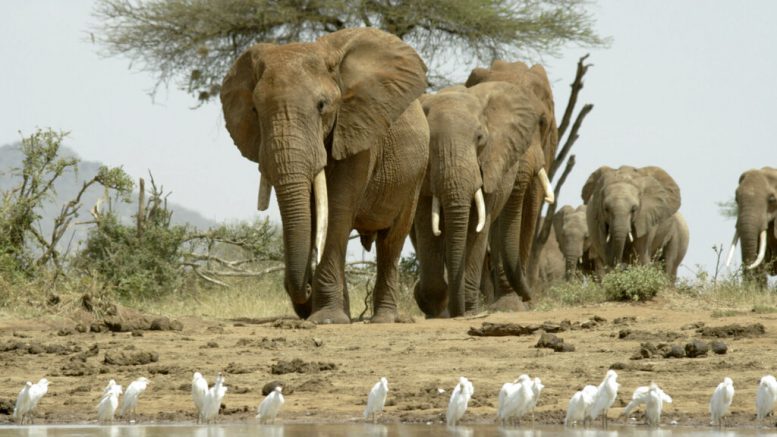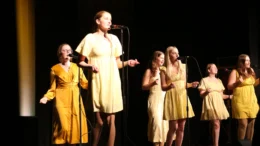NEW YORK (AP) — Forty years ago, the programmers at PBS were eager to experiment, so they took a chance and started a new series on animal behavior in the wild called “Nature.”
The show featured hourlong documentaries from natural landscapes all around the world, and at first, didn’t even have narration so it could be sold in any television market, without any language barrier. It was a hit. “Nature” is celebrating its anniversary this season, which includes an extended look at the Rocky Mountains, American horses, a close examination of bees, and, of course, some adorable penguins.
While the series has evolved over the years, there’s one person who has been there since the beginning. Fred Kaufman started as a production assistant on a three-month stint and has now been the show’s executive producer for the last 30 years.
Kaufman says “Nature” has become even more compelling to viewers because the science, filmmaking, and technology are better. He’s also proud of the show’s storytelling and attention to global warming and the environment. In a recent interview with The Associated Press, Kaufman talked about the evolution of the show, the stories that have made the most impact, and how viral videos have helped the genre.
This interview has been edited for length and clarity.
AP: How has technology changed the show over 40 years?
KAUFMAN: When HD came it was like, ‘Whoa!’ All of a sudden, you saw the detail that you didn’t see before, so that was a big difference. Lenses have gotten better, more diversified. That’s a big difference. Drones! Years ago, if you wanted to get an aerial, you had to hire a helicopter at 400 bucks an hour and pay for the fuel and an operator and just pray that you can get everything you want in an hour … that was like a big deal. Now you put up a drone, one person flies a drone: rocksteady shot. It really allows you to see a landscape, gives you a new perspective on animals and places.… But I think one of the single most important developments is that wildlife films, behavior, little snippets, have become so viral on social media. I mean, they’re fun, they’re dramatic, they’re exciting. Chances are you’ve never seen this before.
AP: How does the show approach which places and animals to cover?
Kaufman: Everything we do is from the animal’s perspective. It’s from the perspective of wild places and wild lands. What’s the animal’s perspective on that? You’re showing it from the photographer’s perspective, but can we shift and make it from the animal’s perspective? And so, it’s…kind of calibrating your thinking and script because it represents the animal’s point of view. What do they need? What are the resources for a healthy environment? How does farming and climate change impact them? So that’s kind of what we go to when we’re thinking about a topic and when we’re reviewing the film. Are we being a voice for the natural world?
AP: How have you observed the effects of global warming?
Kaufman: The most obvious visuals are the shrinking polar caps, particularly in the Arctic. We’re seeing that polar bears are spending more time swimming and not on ice flows because there are less of them. So, they’re more in the open ocean. And this leads to fatigue and they need more food to eat. And they’re suffering because of that. And that’s sort of the most obvious example that we’re all seeing. But climate change is affecting migrations, and birds, for example, migrate following the paths of flowers and food sources that come out because when that day gets longer and the sun shines and it’s warmer and plants bloom, et cetera, birds follow those paths. Now, with global warming, some of those events are happening earlier than usual. So, the birds are showing up late or they’re showing up too early, and it’s messing with the nutrition and the food they need to carry on their migration.
AP: Which shows have had the biggest impact?
Kaufman: One thing I’m super proud of is many, many years ago, we were the first to bring attention to the colony collapse disorder with the bees. And so that one turned out to be a very big story, and it’s still a story.
AP: What is it about nature that still captures people?
Kaufman: The most thrilling thing about being in nature is probably going on an African safari, which just isn’t like anything in the world. I mean, you do feel insignificant when you’re out there and you see these big gorgeous, iconic animals up close. It’s surprising how close these animals come, and you see these magnificent landscapes that go on for miles. It’s awe inspiring. It really gets into you and stays with you and you know, you get goosebumps. We were in a vehicle in the middle of a herd of about 60 elephants in Africa and my heart was racing. I don’t know why. It was just a reaction to being amongst these big wild animals — and elephants are in a class by themselves. And of course, you know, you feel that they’re aware of you in a way other animals aren’t. There’s a consciousness there. And so, there are moments like that I think everybody experiences, whether you’re in Yellowstone National Park or even Central Park, where it just has a calming influence about it.



































